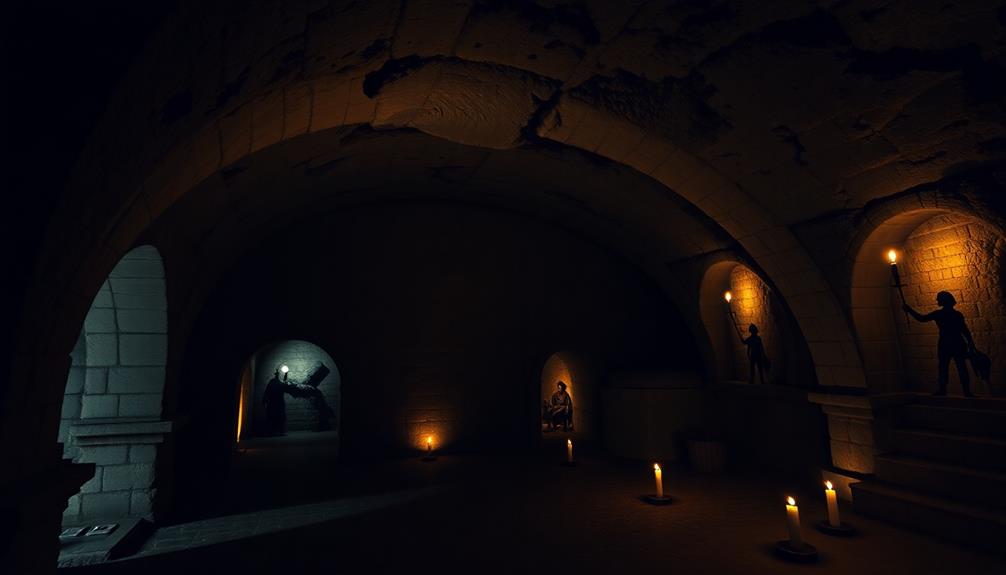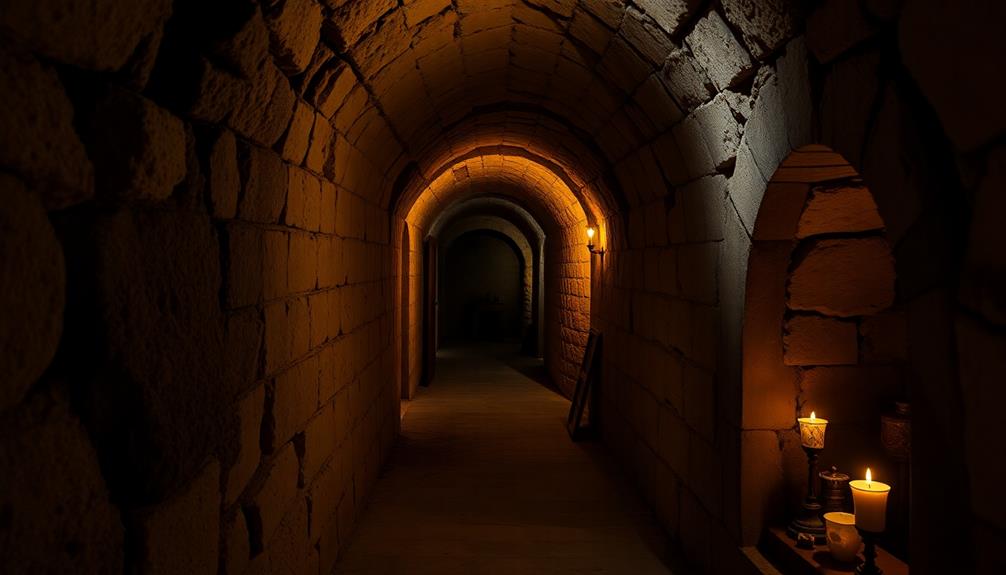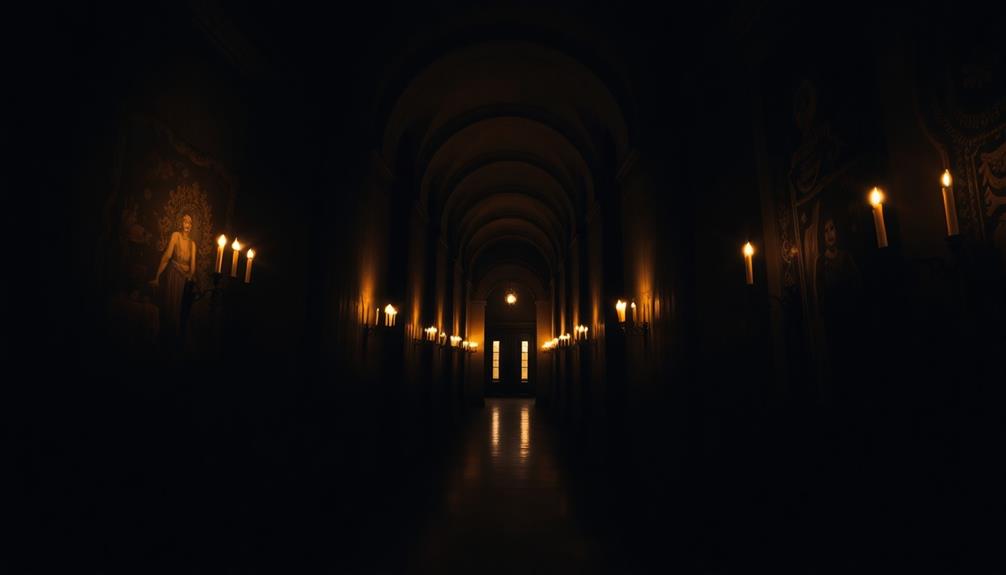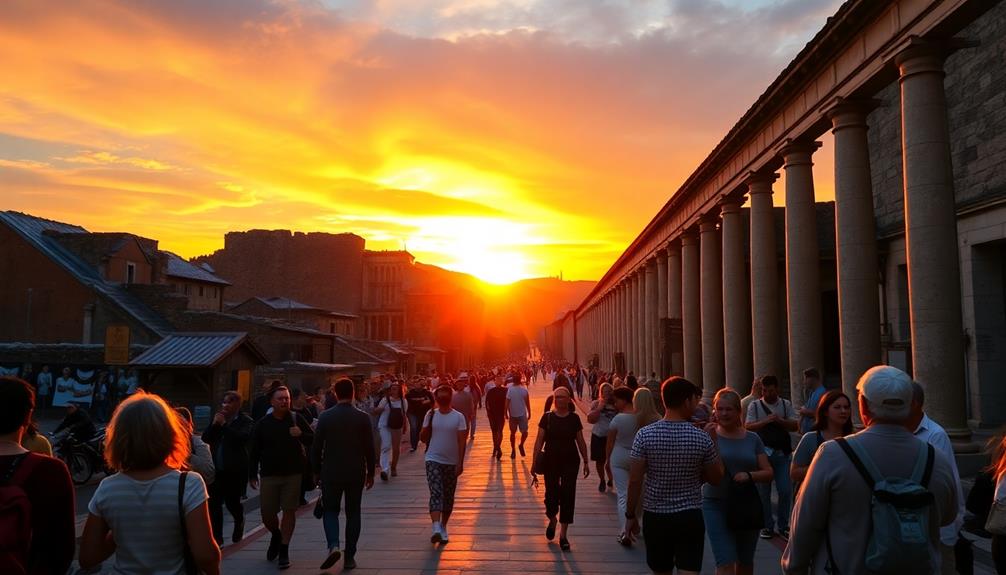When you explore Naples' haunted underground city, you'll uncover a dark tapestry woven from centuries of history, survival, and ghostly legends. The tunnels, created by Greeks and expanded by Romans, served as refuges during WWII, holding stories of resilience amid chaos. Visitors often hear eerie cries and encounter spirits believed to roam the passageways, including the mysterious Munaciello, known as a symbol of luck. As you wander through the remnants of markets and shelters, you'll sense the profound connection this underground world has to the city's identity. Discover more about its chilling tales and vibrant past.
Key Takeaways
- The underground city of Naples dates back to the 3rd century BC, featuring extensive tunnels and historical significance from Greek and Roman times.
- During WWII, the Galleria Borbonica served as a refuge for thousands, fostering unique social dynamics and community resilience amid bombings.
- Haunting legends, including tales of a crying child and WWII spirits, enhance the eerie atmosphere of the underground tunnels.
- The Munaciello spirit symbolizes luck and fertility, evolving from a ghostly figure to a cherished part of Neapolitan folklore.
- Artistic expressions and historical remnants in the tunnels reflect the creativity and bravery of Neapolitans during wartime, preserving cultural identity.
History of the Underground City

The underground city of Naples, often shrouded in mystery, has a rich history that dates back to the 3rd century BC. When the Greeks first arrived, they excavated tunnels for tufa stone, essential for building their temples and structures.
As you explore deeper into the history of Naples, you'll find that the Romans expanded this network in the 1st century BC, transforming it into a sophisticated aqueduct system stretching about 125 miles. This advancement showcases their remarkable engineering prowess.
Fast forward to World War II, and you'll discover that the Naples Underground served as a refuge for thousands. With bombings claiming an estimated 20,000-25,000 lives in the city, these tunnels became critical for survival.
The Galleria Borbonica, initially a large cistern for water, was repurposed as a shelter, emphasizing its historical significance.
Today, preservation efforts aim to maintain the integrity of these tunnels. You can explore remnants of Roman markets and temples that provide a glimpse into the past.
The history of Naples is intricately woven into these underground passages, revealing stories that continue to captivate visitors.
Life in the Bunker

Imagine maneuvering daily life in the cramped, dark tunnels of the Galleria Borbonica during World War II.
You'd quickly learn to adapt, developing survival strategies while forming bonds with others in the same predicament.
This underground world transformed not just the way you lived, but also how you connected with those around you amidst the chaos above.
Daily Survival Strategies
Huddled together in the Galleria Borbonica, families developed daily survival strategies to navigate the challenges of life in the bunker during World War II.
With limited resources and cramped conditions, they relied on each other to endure the oppressive atmosphere. Here are some key strategies they employed:
- Resource Sharing: Families pooled what little food and supplies they had, ensuring everyone had enough to eat.
- Scheduled Activities: Adults took turns cooking and organizing games for children, maintaining a sense of normalcy and community in dark times.
- Ventilation Management: They created makeshift ventilation systems to alleviate the thick air in deeper sections of the tunnels, essential for daily survival.
- Emotional Support: Socializing became critical; sharing stories and laughter helped lift spirits and provided comfort amidst uncertainty.
For many, the Galleria Borbonica wasn't just a refuge from the bombings; it became a new home.
The resilience shown in these strategies demonstrated how human connection and creativity can thrive, even in the darkest moments of history.
Social Dynamics Underground
Life in the Galleria Borbonica during World War II fostered a unique social environment among the residents. As families huddled together in the bomb shelter, they transformed fear into community. In cramped conditions, laughter from children playing with makeshift toys echoed off the damp walls, reminding everyone of a normalcy that seemed distant. Adults gathered to share stories, creating bonds that only war could forge.
The emotional weight of their situation was palpable, yet they found solace in each other. This table illustrates the duality of life underground:
| Joy | Fear |
|---|---|
| Children's games | The sound of sirens |
| Shared meals | Darkness surrounding |
| Stories of hope | Rumors of the haunted |
| New friendships | Loss of homes |
Many residents, having lost their homes, remained in the bunker long-term, reshaping Naples' social structure. Eerie occurrences and ghostly legends added a haunting layer to their experience, making the Galleria Borbonica not just a refuge, but a place where the weight of survival intertwined with the whispers of the past.
Haunting Experiences and Legends

What draws countless visitors to the haunted underground city of Naples is the chilling atmosphere woven with tales of the supernatural.
Walking through the dimly lit tunnels, you can't help but feel a shiver run down your spine. The Galleria Borbonica, in particular, is infamous for its eerie occurrences, leaving even the bravest staff uneasy when entering alone.
Here are some haunting experiences and legends that might catch your attention:
- Many visitors report hearing a crying child's voice echoing through the tunnels, a sound that lingers long after you leave.
- Legends say that the spirits of those who perished during World War II still roam these underground passageways.
- Guides often prefer to venture into the depths with large tourist groups, highlighting a communal fear of encountering something otherworldly alone.
- The Munaciello spirit, believed to have blessed many locals, adds another layer of folklore, intertwining luck and the supernatural in Naples.
As you explore, you might just feel the weight of the past pressing in, making every shadow and sound all the more haunting.
The Munaciello Spirit

Deep within the shadows of Naples' underground, the legend of the Munaciello spirit weaves through the city's folklore, capturing the imagination of many. Known as the "little monk," the Munaciello is a benevolent ghost associated with the pozzari—workers who maintained the underground water systems. Dressed in monk-like robes, this spirit is believed to move household items and bless those it favors with good fortune.
The Munaciello's reputation has evolved over time, transforming from a mere eerie figure to a symbol of luck. Some locals even claim it can predict lottery numbers or bless couples with fertility. The spirit's presence intertwines with tales of infidelity, representing both hope and the supernatural in Neapolitan culture.
Here's a quick overview of the Munaciello spirit:
| Aspect | Description | Significance |
|---|---|---|
| Appearance | Monk-like robes, associated with pozzari | Connection to underground work |
| Abilities | Moves items, bestows good fortune | Symbol of luck and blessing |
| Cultural Impact | Reflects local folklore, intertwines with infidelity | Represents hope and the supernatural |
Cultural and Historical Significance

As you explore the underground city of Naples, you can witness how its tunnels stand as a testament to resilience during wartime, sheltering thousands during bombings.
You'll also encounter the rich folklore, like the legend of Munaciello, which reflects the city's cultural beliefs.
Plus, the artistic expressions found throughout these underground spaces reveal how history and creativity intertwine in this unique urban landscape.
Resilience in Wartime History
Throughout its tumultuous history, Naples has demonstrated remarkable resilience, particularly during the harrowing years of World War II. The Galleria Borbonica, initially a water cistern, became a refuge for thousands during over 200 bombing raids.
Here's how Naples showcased its resilience:
- Community Bonds: Families spent days or weeks in the underground shelters, sharing food and stories, which fostered a strong sense of community amid chaos.
- Adaptability: The transformation of the tunnels from a water supply system to a protective shelter highlights Naples' ability to repurpose its infrastructure in times of crisis.
- Historical Significance: The discovery of remnants from Roman markets and temples within the underground system emphasizes the long-standing importance of these spaces for the city's survival.
- Cultural Legacy: The wartime experiences have inspired local youth to engage in community efforts, blending historical narratives with modern socio-political dynamics.
These elements underscore how Naples not only survived World War II but emerged with a richer cultural identity, deeply rooted in its history and resilience.
Folklore and Local Legends
Naples' rich history isn't just marked by resilience; it's also steeped in enchanting folklore and local legends that reflect its vibrant cultural tapestry.
One of the most intriguing figures is O Munaciello, a spirit believed to bring luck and fertility, originating from the short-statured pozari who worked in the underground cisterns. This connection adds a mystical layer to the stories whispered in Napoli Sotterranea.
Then there's the tale of Parthenope, the siren whose beauty and peril capture the essence of Naples. Her legend intertwines with the city's founding and emphasizes the haunting presence of spirits that linger from its tumultuous past.
The Galleria Borbonica, once an aqueduct and later a WWII bomb shelter, is also a focal point for ghost stories, where the spirits of those lost during the bombings are said to roam.
Eerie occurrences, like unexplained noises and a child's cries, feed into local legends, merging historical trauma with the community's identity.
These stories not only entertain but also highlight the resilience of Neapolitans, preserving their past through mesmerizing folklore that echoes through time.
Artistic Expressions Underground
Exploring the depths of Napoli Sotterranea reveals a hidden world of artistic expression that tells powerful stories of survival and resilience.
The eerie atmosphere of the tunnels enhances your experience, making you feel the weight of history as you encounter various artistic installations. These pieces, created from items unearthed during excavations, reflect the creativity of those who took refuge underground during World War II.
Here are some key aspects of this underground art scene:
- Symbolism of Survival: Artists use materials like crude metal to craft children's toys, representing life in the tunnels.
- Stories of Neapolitan Women: Art connects contemporary expressions with the bravery of women who lived through the war, highlighting their strength.
- Interactive Experiences: Many installations invite you to engage, deepening your connection to the past.
- Cultural Events: Ongoing exhibitions educate visitors about Naples' tumultuous history and the artistic interpretations that emerge from it.
These artistic expressions not only honor the resilience of those who came before but also keep their stories alive for generations to come.
Visitor Access and Tours

Visitors can easily access Napoli Sotterranea, located at Piazza San Gaetano 68 in Naples. You can reach it by taking a taxi, which costs around 10 euros, or using public transport from Rome Termini to Napoli Centrale, which takes between 70 minutes to 3 hours.
Tours are available in both English and Italian, with multiple scheduled times throughout the day, but be mindful of potential COVID-19 restrictions. As you navigate the dark tunnels lit by candles, keep in mind that the narrow passages might trigger claustrophobia, and you'll face a climb of 142 steps to return to the surface.
Here's a quick overview of ticket prices:
| Ticket Type | Price | Notes |
|---|---|---|
| Adult | 10 euros | Standard admission |
| Student | 8 euros | Valid student ID required |
| Under 10 | 6 euros | Child's ticket |
Guided tours reveal the historical significance of the site, showcasing remnants of ancient water systems and World War II graffiti. This immersive experience provides a glimpse into Naples' rich underground history.
Architectural Features and Discoveries

Beneath the bustling streets of Naples lies a remarkable underground system, a network of tunnels initially carved for water supply that stretches approximately 50 miles.
This extensive labyrinth showcases impressive architectural features and intriguing discoveries from various historical eras. As you explore, you'll encounter:
- A 17th-century cistern, a demonstration of the engineering skills of the time.
- Remnants of an ancient Roman theater, hinting at the vibrant culture that once thrived above.
- Graffiti from World War II, serving as a haunting reminder of the shelter's use during bombings.
- The only well in Naples, illustrating the essential role these tunnels played in the city's water management.
The soft tufo stone utilized for construction has created sturdy stone walls, standing strong through centuries.
You'll also find crude stone dividers that were once toilets, showcasing the adaptability of this underground space over time.
Each feature tells a story, revealing the ingenuity of past civilizations while giving you a glimpse into the city's rich history.
As you navigate this hidden world, you'll appreciate how these architectural feats haven't only shaped Naples but also endured through its turbulent past.
Contemporary Context and Impact

In recent years, the underground city of Naples has faced both challenges and opportunities, particularly in light of the COVID-19 pandemic. As the virus swept through, many tourists took shelter from the uncertainty, leading to the temporary closure of sites like Napoli Sotterranea.
These closures forced operators to adapt to new health regulations, ensuring visitor safety while maintaining the allure of the eerie legends that surround this hidden world.
Despite these setbacks, local pride in Naples' chaotic yet vibrant culture has shined through. Tours that educate visitors about the historical significance of the underground city have gained traction, allowing residents to share their rich heritage.
Programs like Stanley Tucci's "Searching for Italy" have also spotlighted Naples, showcasing its underground treasures and attracting international attention.
The growing interest in urban exploration has further fueled curiosity about the extensive network beneath the entire city. With recommendations to visit during the summer months for a cooler experience, more tourists are enthusiastic to uncover the ghostly tales and hidden histories that lie within Naples' haunted depths.
This revival of interest signals a resilient spirit, as the underground city continues to captivate and inspire.
Conclusion
As you wander through Naples' haunted underground city, you can't help but feel the echoes of the past whispering around you. Each shadow seems to share a secret, each creak an invitation to explore deeper. You might stumble upon the Munaciello spirit, just as others have before you, weaving tales of fortune and misfortune. In this labyrinth of history, you'll find that every corner holds a story, and every visit feels like a strange, beautiful coincidence.










